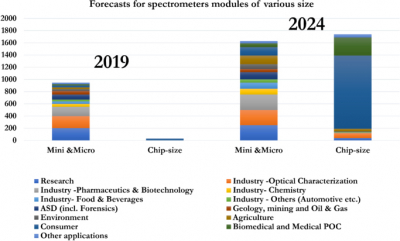
Optical spectrometers are one of the essential types of instruments in numerous fields, including chemical engineering, materials analysis, astronomical science, medical diagnosis and biological sensing. Conventional high-performance spectrometers based on bulky and costly systems can no longer meet the requirements of various emerging application scenarios where the portability, cost, robustness and power-consumption are paramount metrics, such as portable or wearable sensing devices for healthcare, food safety monitoring, smartphone-based spectrometers, drone-based remote sensing and space exploration. During the past decades, substantial progresses have been made by both academia and industry in miniaturising spectrometers while maintaining adequate performance. However, while some work has indeed advanced the state-of-the-art in miniaturised spectrometers, they may suffer from insufficient performance and low technology readiness levels in connection with commercialisation.
In a review paper, researchers from Nanjing University of Aeronautics and Astronautics, University of Cambridge and University of California at San Diego summarised the recent progresses on miniaturised spectrometers with a special focus on integrated spectrometers based on CMOS-compatible integration platforms that hold great promises for massive fabrication at low cost. The paper starts with a brief market analysis of miniaturised spectrometers, showing their rapid growth, especially the chip-size integrated spectrometers which are predicted to have a disruptive increase in market volume from less than US$2 million in 2019 to over US$1.6 billion in 2024. Nevertheless, in general, the footprint reduction of a spectrometer is associated with certain performance degradations regarding its operation bandwidth, resolution, measuring speed, dynamic range or signal-to-noise ratio, making it crucial to customise the spectrometer design for specified application scenarios. Hence, taking the most popular biomedical sensing and industrial chemical detection as examples, the authors summarised a set of key figures of merits in terms of resolution, bandwidth etc., to establish the performance benchmarks for developing the next-generation of integrated spectrometers in various fields.
Afterwards, the paper goes into technological side; the two main categories of integrated spectrometers based on the wavelength de-multiplexing (WdM) and wavelength multiplexing (WM) are discussed successively: “As suggested by their names, the WdM spectrometers need to de-multiplex, or in other words, split the incident signals’ spectra, either spatially or temporally, and measure the intensity of individual channel. On-chip WdM spectrometers are typically implemented by dispersive structures. Alternatively, WdM spectrometers can be implemented by using an array of narrowband filters or a single tuneable narrowband filter, whose spectral responses determine the spectral contents arriving at the detector. In contrast, WM spectrometers do not require to split the spectral contents of the spectrum, they typically pro-modulate the entire spectrum and reconstruct it by signal processing using specific algorithms. Dependent on the modulation principle, they can be further divided into Fourier Transform Spectrometers, or Computational Spectrometers.” Computational spectrometers, which utilises an array of propagation channels with distinct spectral responses to sample the entire spectrum simultaneously, have recently seen extensive study. However, “even if the computational spectrometers exhibit distinct advantages in terms of footprint, dynamic range and measurement time, by the nature of using fewer equations to solve many unknown values they are only able to reconstruct sparse spectra, which refer to smooth spectra or spectra with only a few non-zero components. While for dense spectra that contain rapidly changing features such a series of dips and peaks, the number of filters have to been significantly increased in order to maintain satisfactory performance”, they added.
“To date, silicon photonics is still the most promising platform due to its unique CMOS compatibility. Considering that currently demonstrated integrated spectrometers are still unsatisfactory to the market requirements, we foresee four possible directions for developing the next-generation spectrometers on silicon photonics, involving spectrometers based on active path configuration, spectrometers with programmability, spectrometer systems with parallelism and hybrid integration techniques for spectrometers. We expect to see expanding integration of chip-scale spectrometers into consumer productions within the next few years, providing cost-effective and reliable services to users worldwide”, the authors forecast.










